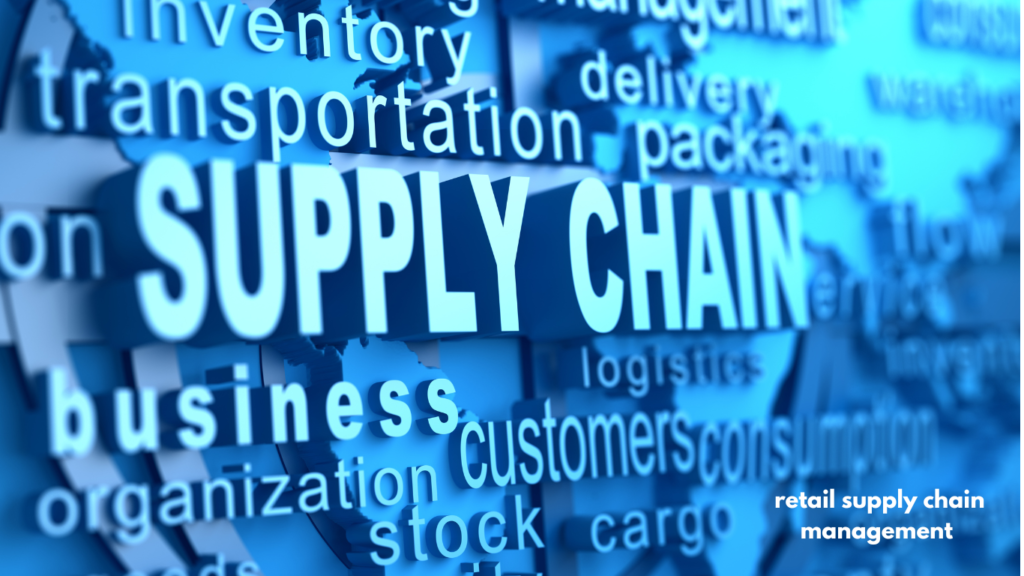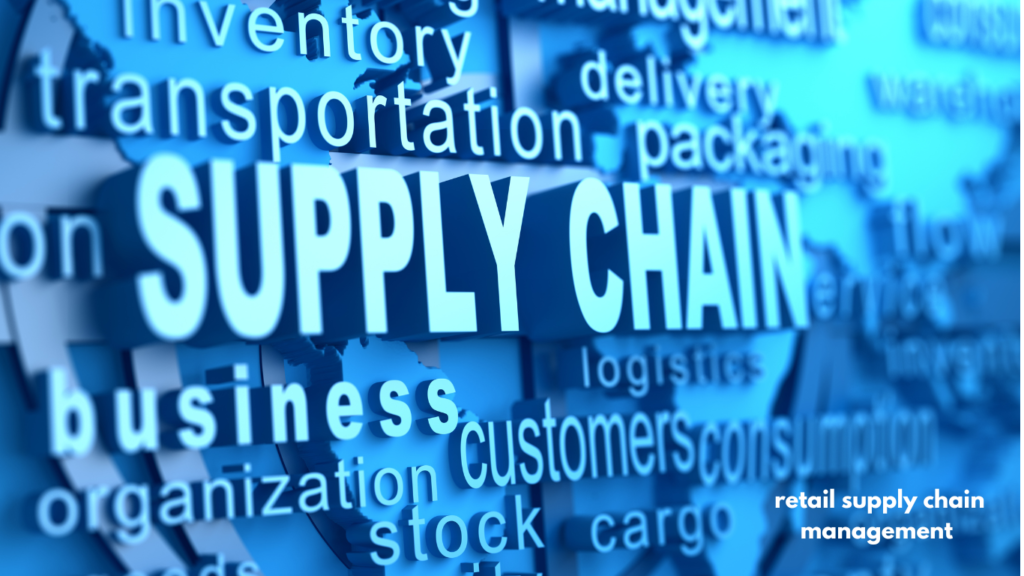Retail is a constantly changing and growing industry. Therefore, managing the supply chain is the key to its success. You have to improve your relationships with suppliers and use technology to streamline all aspects of the supply chains, which can significantly enhance the supply chain performance.
Within retail supply chain management, the supply chain consists of a vast network that oversees the movement of products and services. The ones to do so are the suppliers to the customers’ doorsteps. This intricate system involves several players- raw materials to manufacturers and distributors, retailers and end consumers.
Supply chain management in retail is all about meticulous planning and execution of activities in the network. So, let’s see the best practices that can ensure accuracy and efficiency.

Retail Supply Chain Management Best Practices
Retailers can aim for improvements in their supply chain management by abiding by a few proven strategies. Let’s see them:
1. Real-time Inventory Tracking
Another key issue is the installation of real-time inventory tracking. It will serve informative and accurate level of available inventory. This allows retailers to make informed choices about replenishment, production, and distribution.
As a result, stockout risk is cut along optimal inventory levels; this, in turn, reduces expensive transportation.
2. Optimising Warehouse Operations
An additional best practice for retail supply chain management is how well you run your warehouse. Retailers need a streamlined warehousing operation that includes receiving, putting away, and picking and packing.
For this, a proper layout design of the warehousing is essential. This can help them to use automation and material handling equipment while implementing inventory management systems.
This will enable retailers to cut costs through improved order fulfilment as well as enhancing overall efficiency.
3. Supplier Relationships
One of the keys to having a strong supply chain is to build strong supplier relationships. Retailers work closely with suppliers to establish clear communication channels, agree on performance quality collaborate on inventory planning and forecasting.
This helps to build trust and cooperation, leading to improved product quality, trusted supply chain partners and reduced lead times. Additionally, retailers gain access to new products and innovative tech.
4.Automate Tasks with Tech
Leveraging technology to automate tasks is another good practice for business. With solutions like inventory management software, transportation management systems and warehouse management you can automate repetitive tasks.
Automation gives you time and resources, allowing you to focus on strategic initiatives. It also enhances accuracy, reducing errors and improving supply chain visibility.
Also, retailers must continuously monitor their supply chain performance. It requires data collection and analysis based on key performance indicators (KPIs), like order fulfilment rates and inventory turnover.
Finally, retailers need to continuously monitor and analyse their supply chain performance. Data collection and analysis happen based on key performance indicators (KPIs) and transportation costs. With monitoring and analysis, you can maintain a competitive edge and adapt to market dynamics.
By implementing these best practices, retailers can achieve successful supply chain management for their retail businesses.
Apart from these, there are a few more things they need to focus on.
5. Give Importance to High-Quality Products
Enhancing your retail supply chain management means securing high-quality products at an affordable rate. Therefore, retailers can be on the same page with suppliers or manufacturers identifying their pros and cons.
You can try the services of multiple manufacturers and suppliers before you find the one that suits your business needs. Propose and give them a quotation for the services. It’s crucial to maintain constant communication with all parties. This helps to continue a good supplier relationship that can help in negotiating future prices.
6. Listen to Customers
Understanding the preferences of your customers and when they need it allows you to anticipate the future trends. It helps to maintain the right stock levels. Proven strategies like customer surveys, social media interactions and the help of event organisation. You can also get tech-enabled insights from predictive analytics and data analytics.
Use sales data analysis to identify future demands and emerging trends. Alert your suppliers about this development. Such a proactive approach to enhancing inventory management ensures that your stock remains at par with the rising expectations of your customers.
7.Consult Analytics Tools
It’s hard to survive in the retail sector without any data-driven insights in every area of operation. Various analytics resources will use your data, giving you a comprehensive yet clear view of market dynamics and customer behaviour.
Some of the essential insights you would need for your retail supply chain management solutions are understanding your customers’ preferences, and shopping patterns, and identifying peak sales seasons. These would form the crux of the strategy in retail management.
Get clarity on what your customers like. Decode their shopping patterns and get actionable insights to steer your business in the right direction.
8. Implement Socially Responsible Protocols
Consumers are environmentally conscious. They prefer brands and companies that have green initiatives. Aligning with this movement can make your brand more attractive to customers, thus keeping you relevant.
To achieve this, you need to enhance socially responsible supply chain practices. For instance, minimising your carbon footprint, initiating “green supply chain initiatives”, and partnering with suppliers who have fair labour practices are some of the things you can do.
Adopting these best practices for retail supply chain management is essential. However, there are some challenges or setbacks that you may face in this area. Let’s see what they are.
Challenges in Retail Supply Chain Management
When it comes to adopting retail supply chain management key priorities and practices, you can face certain setbacks. But worry not—- there are ways to circumvent these difficulties as well:
Challenge 1: Evolving Customer Demand
Online shopping has transformed the way consumers interact with brands and companies. The relationships between manufacturers, consumers, brands and retailers are evolving.
Today, consumers want more direct access to where the products are coming from. They want to know more about the sourcing and manufacturing process to ensure that the companies follow ethical methods.
Today, consumers now want more direct access when it comes to knowledge about the products. They want to know more about their sourcing and manufacturing process to see if companies are abiding by ethical practices.
There is a high demand for ethically sourced, sustainable and high-quality products. Customers are now making their purchase decisions based on it. As a result, many brands are striving to meet these standards .
Challenge 2:Increasing Distribution Complexity
With the development of the online marketplace, customers now have access to more channels. They can find the same product on different websites.
Depending on the product, most of these websites will provide an easy route to consumers. Some retailers enjoy in-store retail experience, while others like to shop online. Additionally, there is a third party who does both elements of retail supply chain management.
By managing supply chain logistics companies can maximise their reach and use all the opportunities they target all these kinds of customers. This approach minimizes risks and requires a constant balancing act of risk planning, innovative strategies, and creating a flexible global experience.
Challenge 3: Climate Risks
Climate change significantly impacts supply chains through irregular weather patterns, extreme events, and strategic challenges like transportation and seasonal demand. These risks are a global concern, pushing companies to adopt mitigation measures and build climate resilience into operations.
Investors and reporting standards now assess companies based on their climate risk management. The role of supply chain management in retail industry is to not only reduce risk but also to enhance corporate reputation and align with global sustainability goals.
FAQs: Mastering the Retail Supply Chain Management in 2024
What is retail supply chain management?
Retail supply chain management involves overseeing the flow of goods from suppliers to customers and optimizing inventory, logistics, and distribution to ensure timely product availability and efficiency.
How can supply chain management deal with global shortages?
You can address global shortages by diversifying suppliers, increasing inventory buffers and improving forecasting. Also, enhance your logistics and adopt agile practices to adapt quickly to disruptions.
How can 3PL help supply chains?
3PL providers enhance supply chains by offering expertise in logistics, warehousing, and distribution, reducing operational costs, improving efficiency, and allowing companies.
Conclusion
Mastering retail supply chain management in 2024 involves optimising inventory, enhancing warehouse operations, and building strong supplier relationships. While challenges like evolving customer demands and climate risks persist, adopting best practices can significantly improve supply chain performance. For tailored solutions and expert guidance, explore Qodenext ’s supply chain services to elevate your operations.







